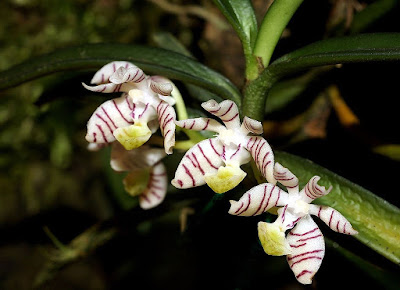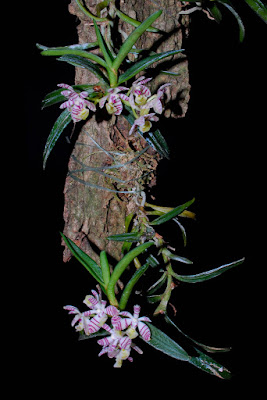Trichoglottis pusilla is native to Sumatra and Java. In Sumatra, these plants are found in many locations in the mountains, at heights of 1600-2000 m, and also encountered near Padang in Air Sirah at an altitude of 1000 m...
Trichoglottis pusilla also called as The Tiny Trichoglottis, Trichoglottis cochlearis, Trichoglottis pusilla f fatoviciana, Vanda pusilla, is a species of the genus . This species was described by Heinrich Gustav Reichenbach in 1856.
IDENTIFY TRICHOGLOTTIS PUSILLA
Trichoglottis pusilla is native to Sumatra and Java. In Sumatra, these plants are found in many locations in the mountains, at heights of 1600-2000 m, and also encountered near Padang in Air Sirah at an altitude of 1000 m. In Java, they meet in the western and central parts of the island. They are popular in most mountain areas of eastern Java, where they grow on higher, small branches of individual trees, where the level of light is high. In Java, they grow at an altitude of 1500-1700 m and are often found in the Engelhardtia spicata trees.
It is a miniature sized, cool growing, monopodial epiphyte with strap-shaped, narrowed apically and unevenly bidentate, v-channeled, 5.5-12.0 cm long and 1 cm wide leaf.
The Tiny Trichoglottis blooms in the fall and winter on an axillary, successively 3 flowering, pale green, purple suffused, axillary, 4 cm long inflorescence with slightly fragrant flowers. The flowers are 1.5-2.3 cm in diameter, they are usually directed downwards, and the flakes of both whorls from the base are curved forward, so that their tops are directed to the center. The petals of both whorls are white and marked with thin, transverse, irregular, reddish-purple stripes. The white lip is yellowish in the middle and has many small, transverse purple dashes at the base. The short, hair-covered rod is white and has purple edges. The edges of the petals of both whorls curl backwards, which makes the front surface very convex. The outer whorls have an ovoid shape, they are blunt ended and expand from the narrow base. The lip is densely covered with hairs between side plots.
TRICHOGLOTTIS PUSILLA CARE AND CULTURE
Cultural information should only be used as a guide, and should be to be adapted to suit you. Your physical location; where you grow your plants, how much time you have to devote to their care, and many other factors, will need to be taken into account. Only then can you decide on the cultural methods that best suit you and your plants.
Light:
Trichoglottis pusilla needs a light level of 25000-35000 lux. The light should be filtered or dispersed, and the plant should not be exposed to the direct sunlight of the midday sun. Strong air movement should be ensured all the time.
Temperature:
Throughout the year, the average day temperature is 22-24 ° C, night 12-14 ° C, with a daily difference of 7-11 ° C.
Humidity:
For most of the year, The Tiny Trichoglottis needs the humidity of 75-80%, and at the end of winter and at the beginning of spring falls to 60-65%.
Substrate, growing media and repotting:
Trichoglottis pusilla grow best in hanging pots or wooden baskets filled with very loose, quickly drying substrate, to which a thicker piece of tree fern is attached. This will provide the basis for the shoots that cling to this piece will grow straight. These orchids can be grown in any loose substrate made of pieces of eg charcoal, wine corks or large pieces of bark of cork oak, just to anchor the plant before it stabilizes. The roots should grow and hang freely and should not be cut to give the plant a nicer habit. Constant air movement around the roots is important.
Watering:
For most of the year, precipitation is abundant, only at the end of winter and at the beginning of spring there is a period of 2-3 months, when it is a bit drier. The cultivated plants should be abundantly watered during active growth, but the substrate around the roots can never be soggy or stale. At the end of autumn, the amount of water should be reduced.
Fertilizer:
Weekly use of 1/4-1/2 of the recommended dose of orchid fertilizer is recommended. You can use high-nitrogen fertilizer from spring to mid-summer, and then until the end of autumn, high-phosphoric fertilizer.
Rest period:
In winter, the amount of water supplied to Trichoglottis pusilla should be reduced, especially if they grown under the conditions of a short, dark day prevailing in winter, but they should not dry up completely. Occasional morning fogging between waterings should provide enough moisture. Fertilization should be reduced or eliminated until new growth occurs in spring, when normal watering begins.















COMMENTS